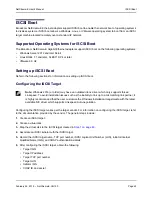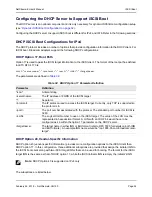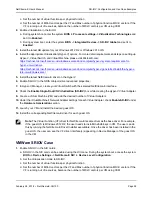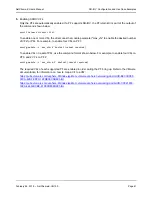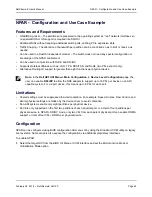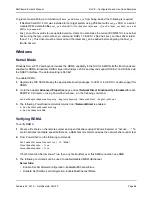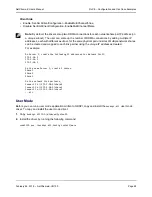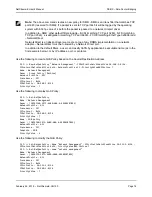
NPAR – Configuration and Use Case Example
NetXtreme-E User’s Manual
February 26, 2018 • NetXtreme-E-UG100
Page 62
NPAR – Configuration and Use Case Example
Features and Requirements
•
OS/BIOS Agnostic – The partitions are presented to the operating system as "real" network interfaces so
no special BIOS or OS support is required like SR-IOV.
•
Additional NICs without requiring additional switch ports, cabling, PCIe expansion slots.
•
Traffic Shaping – The allocation of bandwidth per partition can be controlled so as to limit or reserve as
needed.
•
Can be used in a Switch Independent manner – The switch does not need any special configuration or
knowledge of the NPAR enablement.
•
Can be used in conjunction with RoCE and SR-IOV.
•
Supports stateless offloads such as, LSO, TPA, RSS/TSS, and RoCE (two PFs per port only).
•
Alternative Routing-ID support for greater than eight functions per physical device.
Limitations
•
Shared settings must be suppressed to avoid contention. For example: Speed, Duplex, Flow Control, and
similar physical settings are hidden by the device driver to avoid contention.
•
Non-ARI systems enable only eight partitions per physical device.
•
RoCE is only supported on the first two partitions of each physical port, or a total of four partitions per
physical device. In NPAR + SRIOV mode, only two VFs from each parent physical port can enable RDMA
support, or total of four VFs + RDMA per physical device.
Configuration
NPAR can be configured using BIOS configuration HII menus or by using the Broadcom CCM utility on legacy
boot systems. Some vendors also expose the configuration via additional proprietary interfaces.
To enable NPAR:
1.
Select the target NIC from the BIOS HII Menu or CCM interface and set the Multi-Function Mode or
Virtualization Mode option.
Note:
In the
Dell UEFI HII Menu-> Main Configuration -> Device Level Configuration
page, the
user can enable
NParEP
to allow the NXE adapter to support up to 16 PFs per device on an ARI
capable system. For a 2 port device, this means up to 8 PFs for each port.


